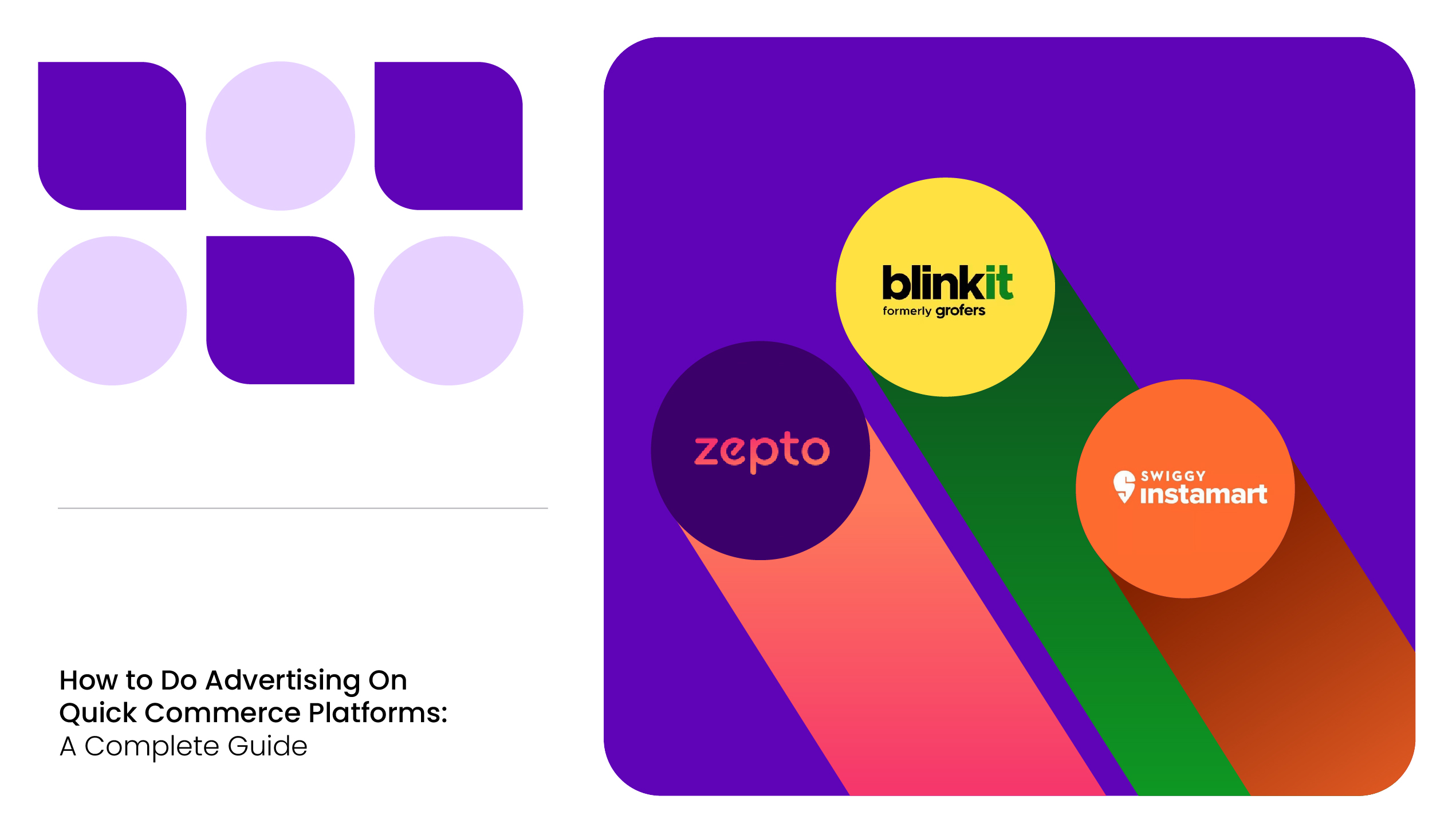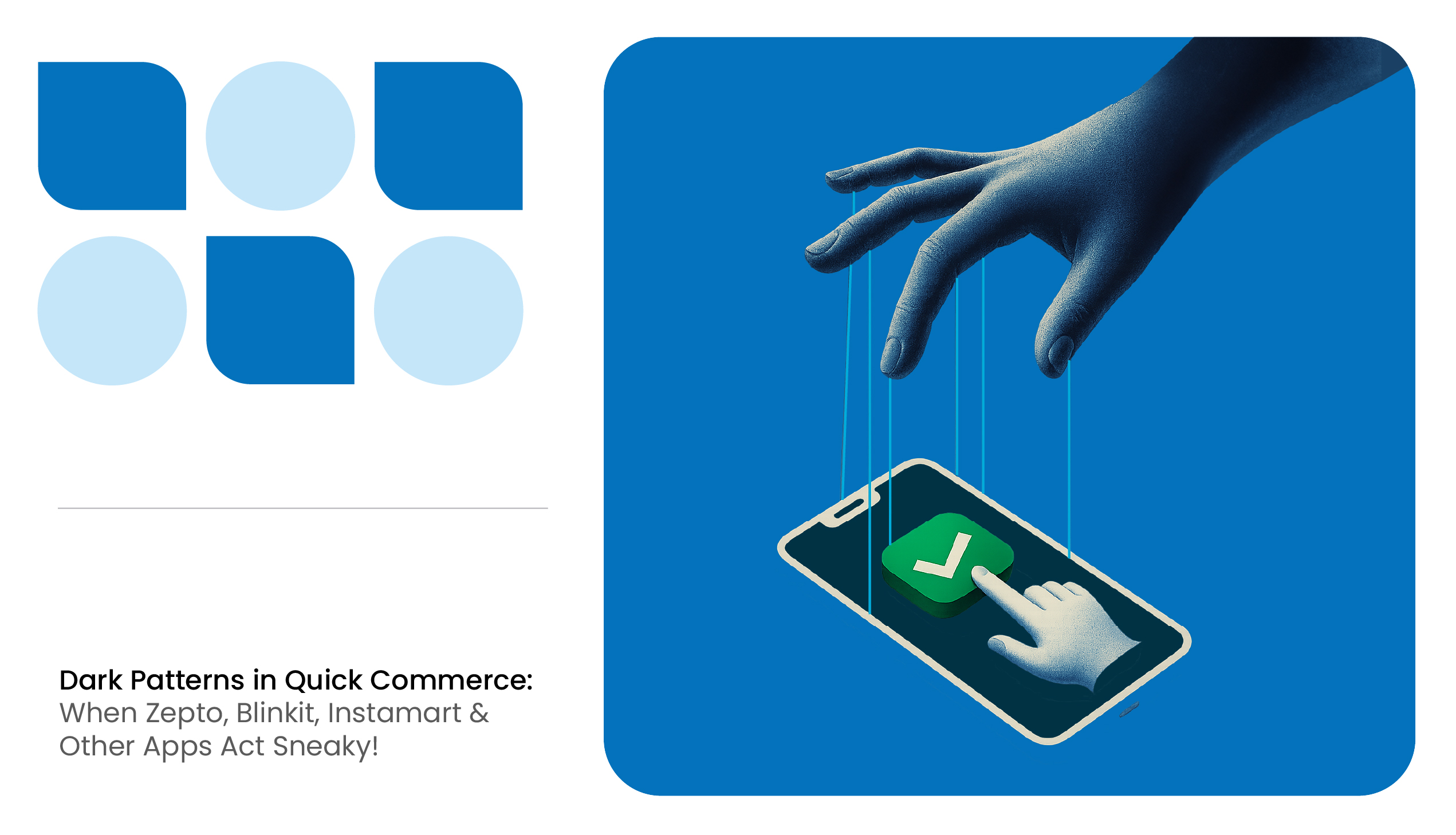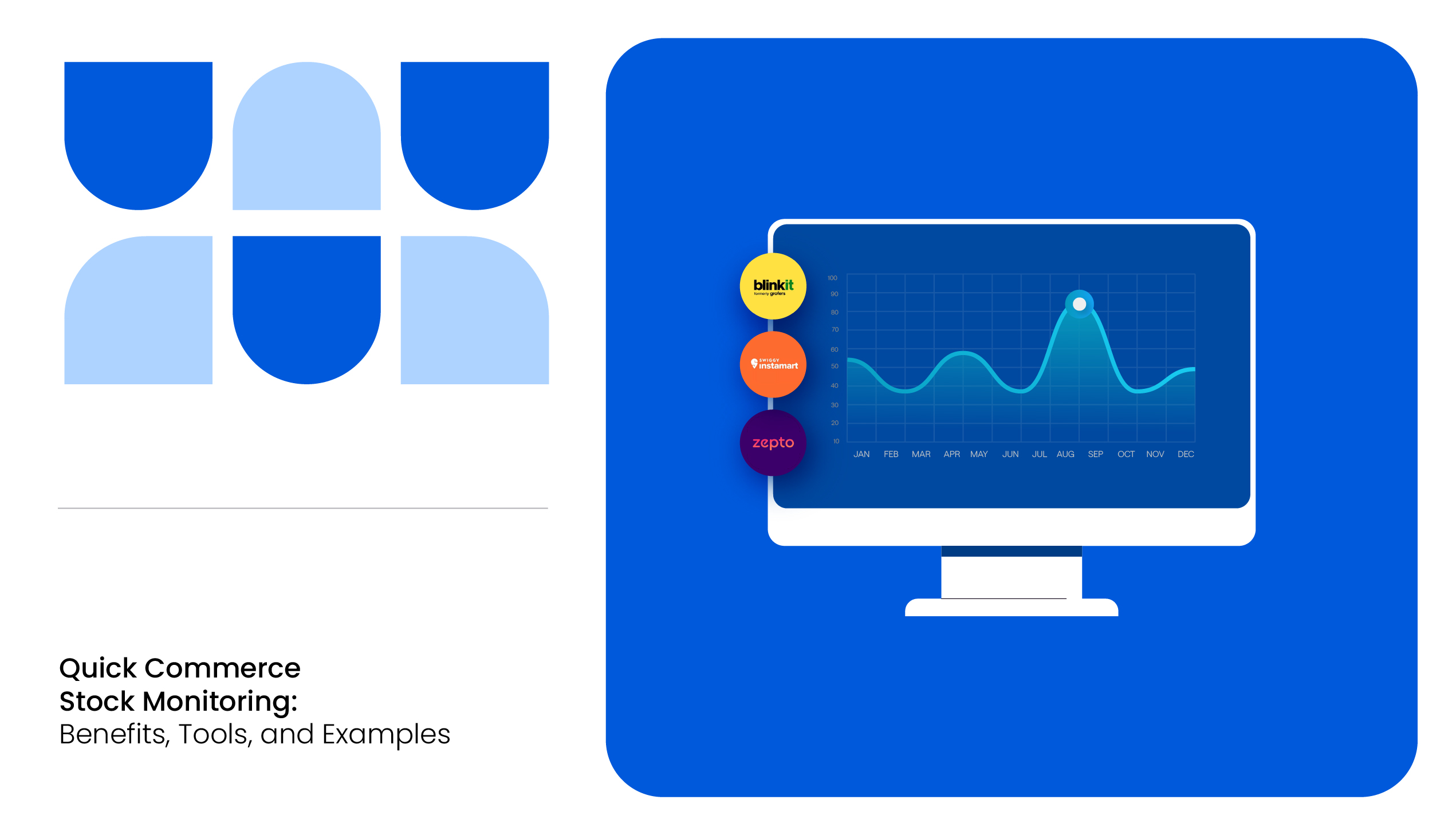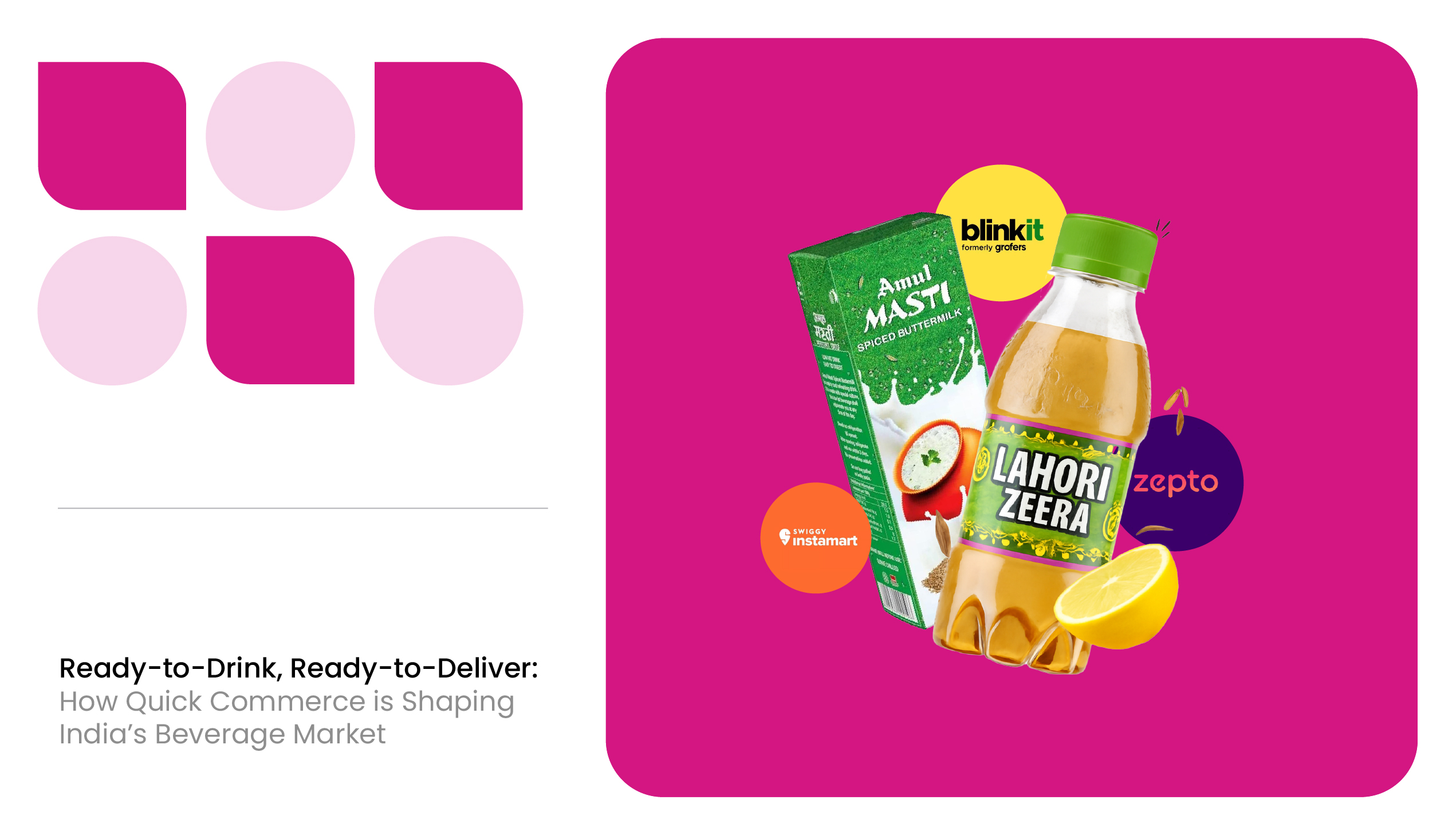Quick commerce platforms, such as Zepto, Blinkit, and Swiggy Instamart, have become the primary shopping destination for Indian households. In March 2025 alone, these platforms collectively fulfilled over 4 million orders each day.
This trend isn’t limited to India. In China, Meituan and JD Daojia are reshaping grocery delivery by integrating it with super apps. In Europe, Gorillas and Getir make hyperlocal delivery mainstream. And in the United States, Instacart and Gopuff are combining dark store efficiency with large retail partnerships.
For brands and retailers, this creates a powerful advertising environment, where they can meet consumers at the point of need and turn visibility into near-instant conversion. In this article, we’ll discuss:
- How brands benefit from advertising on quick commerce platforms
- How to advertise on quick commerce
- Best practices in quick commerce advertising
Benefits of Advertising on Quick Commerce Platforms
Quick commerce shoppers don’t browse leisurely; they arrive with intent and make decisions quickly. This compressed path-to-purchase brings benefits such as:
Boost Brand Awareness
Securing premium placements in quick commerce apps is like getting eye-level shelf space in a high-traffic supermarket. Banner ads, sponsored listings, and app homepage features expose your brand to thousands of daily active users. According to GumGum’s research, these targeted ads can increase brand recall by 70%, making them a fast lane for building awareness.
For emerging brands, this quick commerce marketing strategy helps build awareness quickly; for established players, it reinforces top-of-mind presence in competitive categories.
Quick commerce advertising also levels the playing field. Even if you are a smaller brand without offline dominance, strategic ad placements allow you to compete with household names by being front and center during the shopper’s decision-making process.
Reach High-Intent Shoppers in Real-time
Shoppers often open their quick commerce apps with a specific need, such as milk for tomorrow morning, detergent for today’s laundry, or snacks for tonight’s get-together. This immediacy means your ads are directed toward an audience that is already in buying mode.
It helps you capture high-intent customers at the precise moment they are actively browsing, significantly increasing the chances of conversion compared to social media or display ads, where intent is lower.
Accelerate Path-to-Purchase
Traditional campaigns may generate awareness, but they require days or weeks before consumers take action. In quick commerce, this path-to-purchase cycle is compressed. A shopper sees your ad, clicks on it, and checks out, likely within 10 minutes.
This immediacy not only drives faster revenue but also provides a tighter feedback loop for marketers. You can also track performance data in near real-time to adjust targeting, offers, and creatives within hours, rather than waiting weeks.
READ MORE | Quick Commerce Brand Strategy: 8 Tips To Achieve Top-Tier Brand Performance
How to Advertise on Quick Commerce Platforms: Step-by-Step Process
Advertising on quick commerce platforms requires more than just placing products in front of shoppers. You must align your ads with the right SKUs, target the right audience, and adjust campaigns in real-time, in addition to following the mechanics of each platform.
Here is a structured process you can follow to maximize the effectiveness of your quick commerce advertising.
Product Selection & Listing Optimisation
Your ads are only as strong as the products behind them. Start by choosing SKUs that align with quick commerce consumption patterns. High-velocity items, small packs, and impulse categories such as snacks, beverages, or personal care products are a good start.
Once the SKU is decided, optimise its listings with clear titles, concise but keyword-rich descriptions, and attractive product images. Also, highlight USP-driven attributes, such as sugar-free, organic, family pack, and travel-friendly, to influence shoppers who often make split-second choices.
For example, say you’re a beverage brand launching a new energy drink. Instead of a plain listing, you showcase it with a bold, eye-catching pack shot and a snappy line like “Zero sugar. Instant energy.” Now place it under the ‘Evening Refreshments’ category, where young professionals are likely to scroll after work. You’ve not only caught their eye but also matched the exact moment they’re looking for a pick-me-up.
Audience Targeting & Segmentation
Unlike broad social ads, quick commerce platforms enable you to zero in on shopper behavior. You can use targeting options such as demographics, location, purchase history, and time-band filters.
Also, segment users by purchase triggers: health-conscious buyers, parents shopping for kids, or late-night snackers. Then, geo-target ads near high-density dark stores where your products are stocked to avoid out-of-stock issues.
For instance, a sports drink brand can run campaigns immediately after evening gym hours in metropolitan areas, while a baby food brand targets morning grocery runs in family-heavy neighborhoods.
Campaign Setup & Channel Selection
Most platforms offer a mix of placements, including sponsored listings, banners, category highlights, and sampling programs. Different ad formats serve different goals:
- Sponsored product ads: Capture demand in search (e.g., “detergent” search shows your brand first).
- Banner placements and trial programs: Ideal for launches, building awareness, and encouraging repeat purchases.
- Bundle promotions: Encourage larger baskets (e.g., chips, cola, and dip).
- Category highlights: These are curated special zones, such as “Bestsellers,” “Health Picks,” or “Weekend Essentials.”It helps add credibility and draws organic attention.
- Seasonal and festival slots: Helps capitalize on seasonal demands.
Before investing, match your campaign objective with the appropriate ad format. If your goal is to grab attention in a crowded aisle, invest in sponsored listings. Launching something new? Pair a banner with a sampling program so shoppers can see it and try it, and so on.
Real-Time Optimization
Quick commerce operates in a fast-moving environment where demand patterns, competitor activity, and stock availability can change daily. This means your campaign performance can shift by the hour, and you must monitor data closely to reallocate spend or swap creatives quickly as needed.
Key actions include:
- Reallocating budgets to high-performing SKUs or time slots.
- Pausing ads on out-of-stock products to avoid wasted spend.
- Refreshing creatives frequently to maintain engagement.
- Responding to competition: If a rival brand increases bidding on a category, adjust your campaign to maintain visibility.
Reporting & Performance Analysis
Post-campaign analysis should go beyond CTRs and impressions. Quick commerce platforms offer dashboards with key metrics, including Return on Ad Spend (ROAS), Cost Per Click (CPC), and conversion rate. To get a complete picture, integrate this with your internal sales and inventory data.
For example, if ad clicks are high but conversions are low, the issue may be related to pricing gaps, stockouts, or poorly optimized product content. Consistently analyzing these insights helps you refine campaigns and allocate spend more effectively.
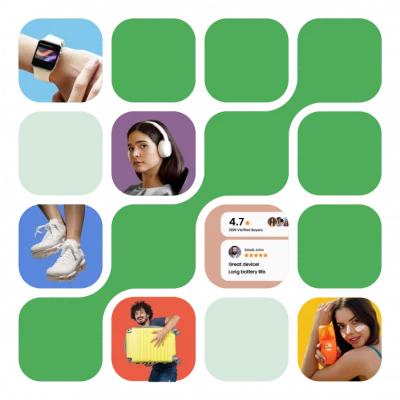
Best Practices in Quick Commerce Advertising
The competition for shopper attention is intense, and even minor tweaks in execution can make a huge difference. Here are three best practices you can follow when running ads on quick commerce:
Use Attractive Images and Concise Descriptions
On mobile-first platforms, visuals do most of the selling. A blurry pack shot or a cluttered description can stop a purchase before it begins. So, invest in clean, high-resolution images accompanied by a concise, benefit-driven description that clearly showcases your product. Also, pay attention to colors and packaging details that stand out on a small screen.
Here’s an example. If your product is instant oats, use a sharper picture of the oats in a bowl with steam rising to reinforce convenience and appetite appeal. Also, instead of “Instant Oats, 500g,” use “Instant Oats – High Fiber, Ready in 3 Minutes” within the image.
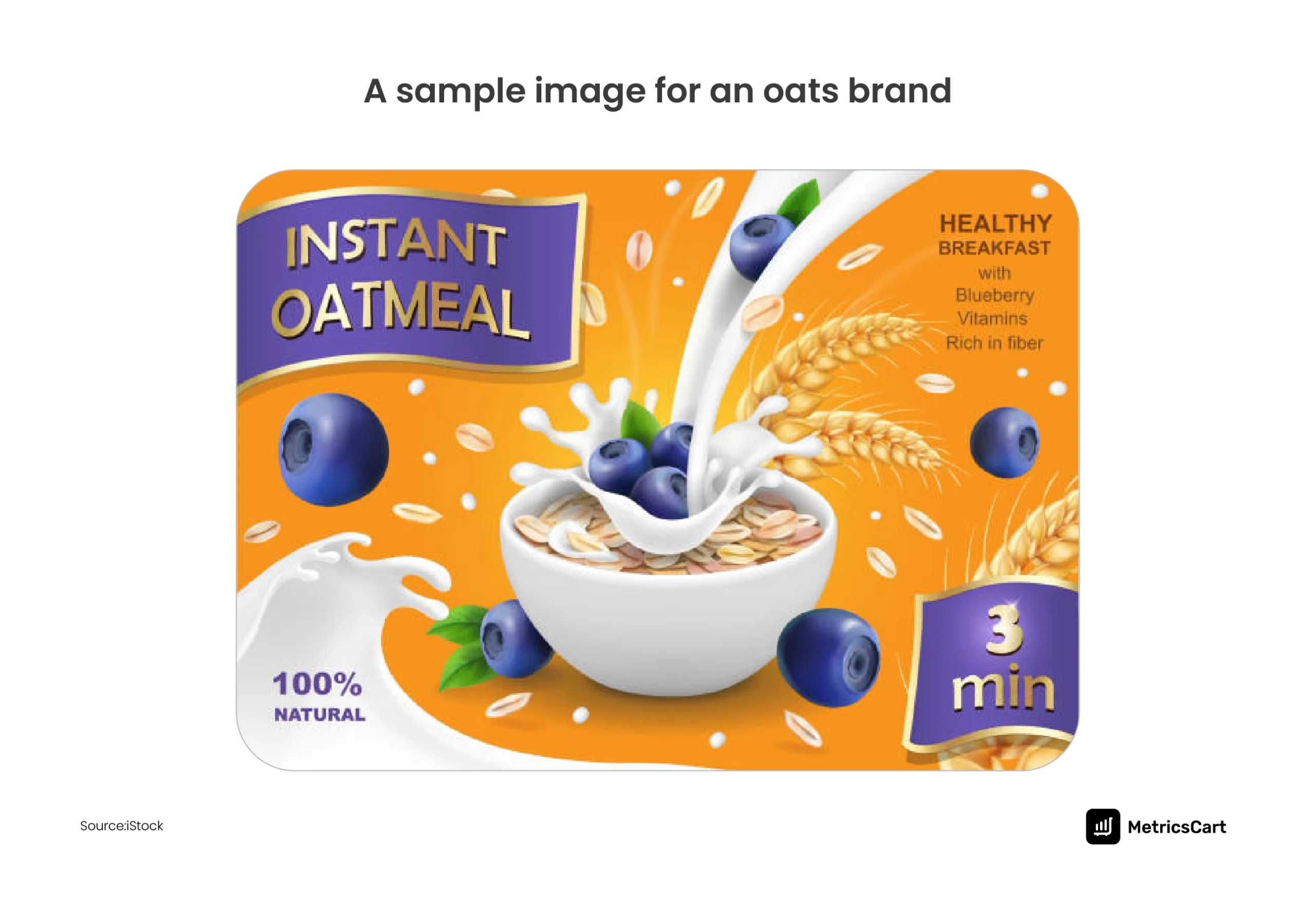
READ MORE | The Hidden Costs of Inconsistent Product Content: Are You Losing Sales?
Maintain the Mindset of a Performance Marketer
Quick commerce advertising is not brand vanity. It’s measurable, performance-driven marketing. Every rupee should be tied back to outcomes such as conversions, basket growth, or repeat purchases.
This means you must treat your ad campaigns like ongoing experiments: test creatives, refine targeting, and reallocate budgets to what works. Setting clear KPIs, such as ROAS, customer acquisition cost, or incremental category share, and closely monitoring them to ensure effective performance will help you achieve it.
For instance, a beverage brand might test two creatives for its iced tea. One focusing on “Low Calorie” and the other on “Refreshing Taste.” If the “Low Calorie” ad delivers 25% higher click-through rates, budgets can be quickly shifted to it to maximize ROI.
Follow Time-Band Strategy
The time-band strategy is simply a way of saying: show people ads when they’re most likely to make a purchase. Shoppers don’t buy the same things all day long. Their needs change with the clock. In the morning, they’re looking for bread, milk, or coffee. By evening, it’s snacks and cold drinks. Late at night, ice creams and desserts suddenly become popular.
This means, if you’re a coffee brand, it makes sense to push ads between 7–10 AM when everyone’s starting their day. However, if you sell ice cream, your best opportunity is after 9 PM, when people get those late-night cravings.
READ MORE | Digital Shelf Monitoring for CPG: 5 Best Practices to Follow in 2025
Conclusion
Advertising on quick commerce platforms enables you to put products in front of shoppers at the exact moment of intent; however, success depends on execution. You must choose the right SKUs, time campaigns effectively, and optimize the ads in real-time.
To do this effectively, brands need more than ad spend. They need visibility into how their products and those of their competitors are performing across various quick commerce platforms. MetricsCart‘s quick commerce dashboard helps brands get this information.
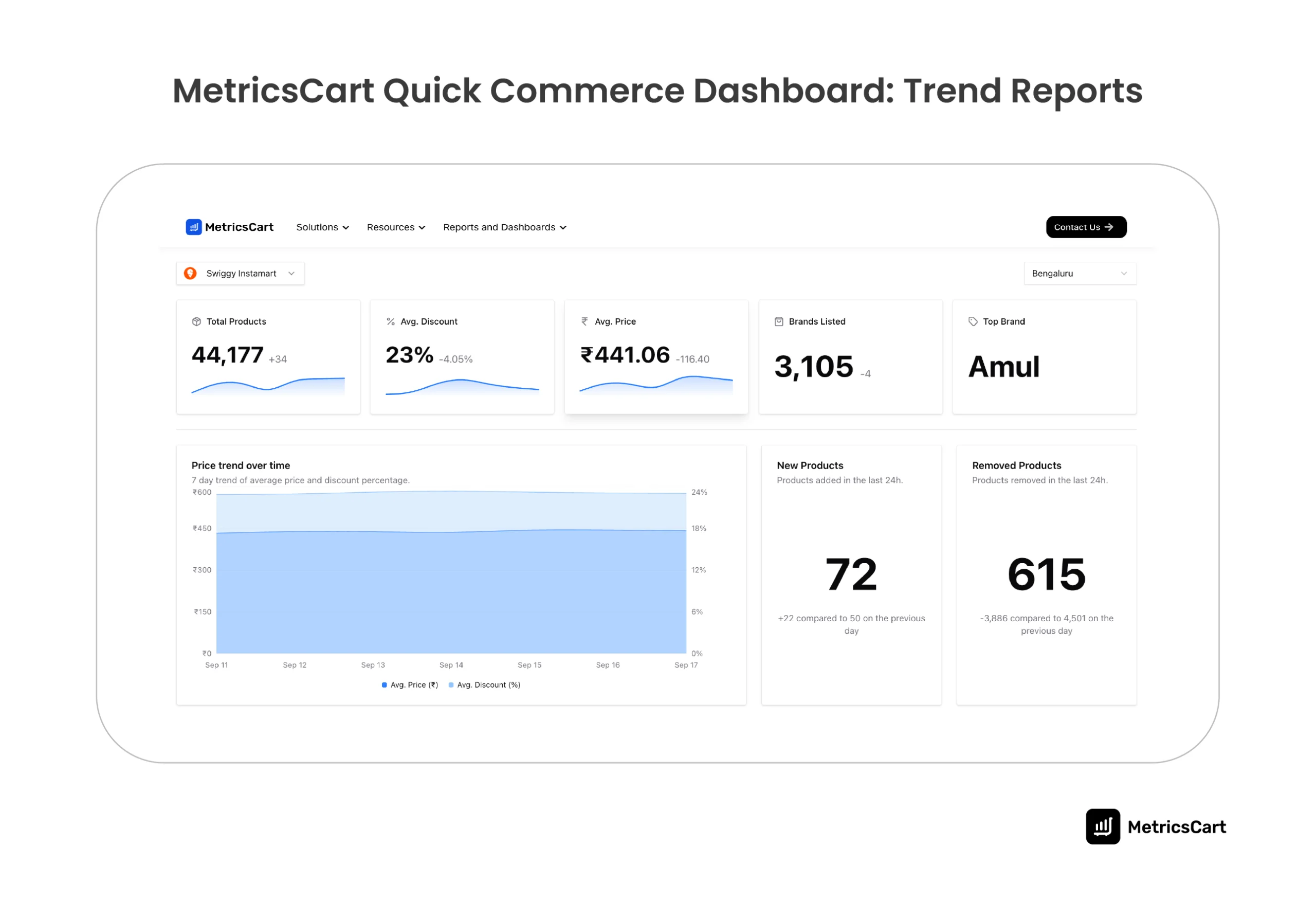
By giving you detailed insight into daily trends and category reports, it lets you:
- Track SKU-level performance across platforms and cities.
- Identify high-intent keywords for targeted ads.
- Benchmark pricing, promotions, and availability against competitors.
- Identify top-performing categories and bestsellers.
- Spot gaps in assortment or stock that could hurt visibility.
- Refine advertising strategy with real-time, data-backed decisions, and more.
These in-depth insights from MetricsCart let you anticipate market changes and become proactive, instead of reactive. As quick commerce evolves daily, the brands that act on real-time intelligence will be the ones to capture shopper attention, protect market share, and scale more quickly.
Use MetricsCart to Stay One Step Ahead of Your Quick Commerce Competitors.
FAQs
Quick commerce advertising refers to paid placements—like sponsored listings, banners, and combo promotions—on platforms such as Zepto, Blinkit, and Swiggy Instamart. These ads help brands get visibility in front of shoppers at the exact moment of purchase intent.
Because shoppers on quick commerce platforms are high-intent buyers. They log in to purchase immediately, not just browse. Ads in this space drive faster conversions, increase brand recall, and help brands compete directly at the point of sale.
Start with fast-moving SKUs that fit quick commerce consumption patterns—small packs, impulse categories (snacks, beverages, desserts), or high-demand staples like milk and bread. Seasonal products and promotional launches also perform well.
It depends on your goal. Sponsored listings work best for capturing search demand, while banners are great for awareness and launches. Combo offers encourage larger baskets, and category highlights boost credibility by placing your product in curated “bestseller” zones.
The time-band strategy means scheduling ads when consumers are most likely to buy certain products. For example, bread and milk in the morning, snacks and drinks in the evening, and desserts or ice creams late at night. This helps maximize ad efficiency and conversions.

